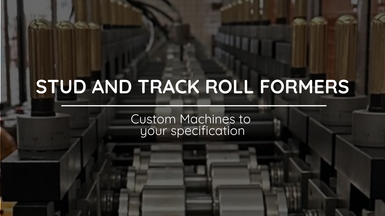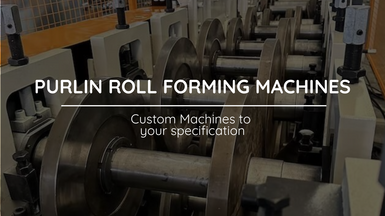
Steel Framing Roll Forming Machine
Here's how a typical Steel Framing Roll Forming Machine works:
Posted on Tuesday, November 21, 2023
Steel Framing Roll Forming Machine Description
A Steel Framing Roll Forming Machine is a piece of industrial equipment used in the construction industry to manufacture steel frames and structural components for buildings and other structures. This machine is specifically designed to take flat strips or coils of steel and transform them into the desired shape and size for constructing frames, studs, joists, and other structural elements used in the construction of buildings.
Here's how a typical Steel Framing Roll Forming Machine works:
- Material Feeding: The process begins with feeding flat strips or coils of steel into the machine. These strips are often made from galvanized steel or other materials with suitable properties for construction.
- Roll Forming: The heart of the machine is a series of rollers and dies that gradually bend the steel strip into the desired shape. These rollers are precisely configured to create the specific profile needed for the steel framing components. The strip passes through multiple sets of rollers, with each set performing a specific bending or shaping operation. As the steel strip progresses through the machine, it gradually takes on the desired shape and size.
- Cutting: After the steel has been formed into the desired shape, a cutting mechanism is used to cut the formed steel into the required lengths. This ensures that the steel framing components are produced in uniform lengths.
- Stacking and Collection: The finished steel framing components are then typically stacked or collected for further processing or transport to the construction site.
Advantages of using a Steel Framing Roll Forming Machine include:
- Precision: These machines can produce steel framing components with high precision and consistency, ensuring that each piece meets the required specifications.
- Efficiency: Roll forming machines are capable of high-speed production, making them efficient for large-scale construction projects.
- Customization: Manufacturers can easily customize the machine to produce different profiles and sizes of steel framing components to meet specific project requirements.
- Reduced Material Waste: The roll forming process minimizes material waste compared to other manufacturing methods.
- Cost-Effective: Over the long term, using a roll forming machine can be cost-effective due to its efficiency and reduced material waste.
Steel framing is commonly used in commercial and residential construction because of its strength, durability, and versatility. Steel Framing Roll Forming Machines play a crucial role in the efficient and precise manufacturing of these framing components, helping to streamline the construction process.
Cold Formed Steel Framing
Cold-formed steel framing (CFSF) is a construction method that involves the use of cold-formed steel members to create structural and non-structural framing systems for buildings and other structures. Cold-formed steel is steel that is shaped and formed at room temperature (as opposed to hot-rolled steel, which is formed at high temperatures), typically through a process known as roll forming. Cold-formed steel framing is known for its strength, durability, and versatility, making it a popular choice in various construction applications.
Here are some key aspects of cold-formed steel framing:
- Material: Cold-formed steel framing is typically made from galvanized steel coils or sheets, which are then formed into various shapes and profiles using a roll forming machine. The galvanized coating provides corrosion resistance to the steel.
- Profiles: Cold-formed steel members come in various shapes and profiles, including C-shaped (C-section or channel), U-shaped (U-section or track), Z-shaped (Z-section), and various custom shapes. These profiles are used for different framing elements such as studs, joists, headers, and tracks.
- Applications: Cold-formed steel framing is used in both residential and commercial construction for a wide range of applications. It is commonly used for wall framing, floor framing, roof framing, and interior partitions. It can also be used in load-bearing and non-load-bearing walls and as a structural support system for cladding and facade elements.
- Benefits:
- Strength and Durability: Cold-formed steel framing is known for its high strength-to-weight ratio, making it a strong and durable choice for structural framing.
- Precision: Roll forming machines can produce steel framing components with high precision and consistency, ensuring accurate dimensions and straightness.
- Fire Resistance: Cold-formed steel framing has inherent fire-resistant properties, as steel does not burn or contribute to the spread of fire.
- Lightweight: Cold-formed steel members are lightweight compared to traditional wood or hot-rolled steel, making them easier to handle and transport.
- Resistance to Termites and Rot: Unlike wood, cold-formed steel is not susceptible to termites or rot.
- Sustainability: Cold-formed steel framing is considered a sustainable building material due to its recyclability and low waste generation during the manufacturing process. Additionally, it can contribute to energy efficiency in buildings when used as part of a well-insulated envelope.
- Building Codes: The design and construction of cold-formed steel framing are typically governed by building codes and standards established by organizations such as the American Iron and Steel Institute (AISI) and the Steel Framing Industry Association (SFIA).
Overall, cold-formed steel framing is a versatile and cost-effective construction material that offers several advantages, including strength, durability, and ease of installation, making it a popular choice for a wide range of construction projects.
Steel Frame Profiles
Steel frame profiles, also known as steel framing members or steel sections, refer to the various shapes and profiles of steel used in construction to create structural and non-structural components of buildings and other structures. These profiles are typically made from cold-formed steel and are designed to meet specific load-bearing and structural requirements. Here are some common steel frame profiles used in construction:
- C-Channel (C-Section or Channel): C-channel profiles are shaped like the letter "C" and are widely used in framing walls, roofs, and ceilings. They are often used as studs and track members in wall framing systems.
- U-Channel (U-Section or U-Profile): U-channel profiles have a "U" shape and are commonly used for framing applications, such as headers, joists, and purlins.
- Z-Channel (Z-Section or Z-Profile): Z-channel profiles have a "Z" shape and are used in various applications, including structural support and bridging between parallel framing members.
- Hat Channel (Hat Section or Hat Profile): Hat channel profiles resemble the shape of a hat and are used as furring channels to attach finishes like drywall or insulation to steel framing systems.
- I-Beam (I-Section or I-Profile): I-beam profiles have an "I" shape and are often used as primary structural members in building frames. They have high load-bearing capacity and are commonly seen in steel structures such as bridges and high-rise buildings.
- Hollow Structural Section (HSS): HSS profiles are hollow steel sections available in various shapes, including square, rectangular, and circular. They are commonly used in structural applications, providing strength and stability while also being lightweight.
- Angle Iron (L-Section or L-Profile): Angle iron profiles have an "L" shape and are used for various purposes, including bracing, framing corners, and supporting structural elements.
- Tee Section (T-Section or T-Profile): Tee section profiles have a "T" shape and are used in applications where a horizontal member must connect to a vertical one, providing support and stability.
- Custom Profiles: In addition to standard profiles, custom steel profiles can be designed and manufactured to meet specific project requirements, offering flexibility in design and construction.
The choice of steel frame profiles depends on the structural design, load-bearing requirements, and architectural considerations of the building or structure. Engineers and architects select the appropriate profiles to ensure that the framing system can support the loads imposed on it while meeting safety and performance standards. Cold-formed steel framing, with its various profiles, offers versatility and strength for a wide range of construction applications.
All our machines are all due to variations in the customer's demand, and we are always ready to assist with any issues. All machines are assembled by our expert team in Orlando, Florida. We have been leading the Roll Forming Machine market since 2009, and have great expertise, so you will be in safe hands. For further information, contact our team here.
For more Machines, browse our extensive range here
Roll Forming Machines LLC's New Factory
Posted on Sunday, March 23, 2025
We have relocated factories, which will be available for tours very soon.

Uncoiler, Decoiler and Coil Car Roll Forming Machine Accesories from Roll Forming Machines LLC
Posted on Sunday, November 24, 2024
Contact us today with your specifications for a custom Uncoiler, Decoiler or Coil Car at [email protected] or call us at (+1) (407) 859 1119

Stud and Track Roll Forming Machines from Roll Forming Machines LLC
Posted on Saturday, November 23, 2024
Contact us today with your specifications for a custom Stud and Track Machine at [email protected] or call us at (+1) (407) 859 1119

Cee and Zee Purlin Roll Forming Machines from Roll Forming Machines LLC
Posted on Saturday, November 23, 2024
Contact us today with your specifications for a custom Cee and Zee Purlin Machine at [email protected] or call us at (+1) (407) 859 1119